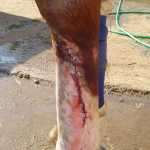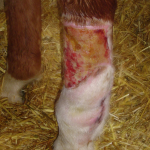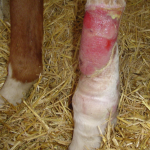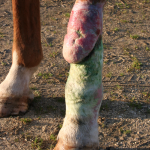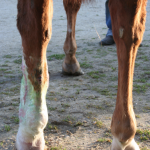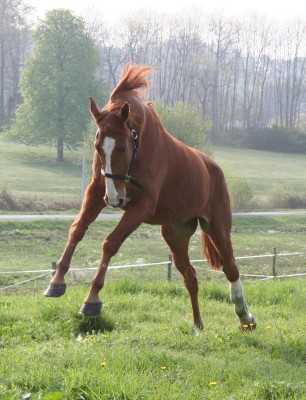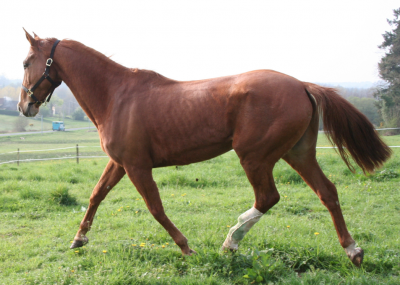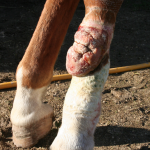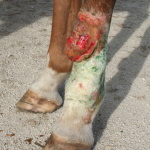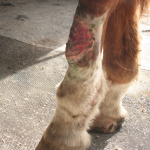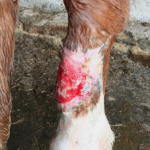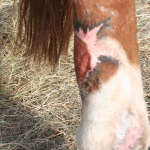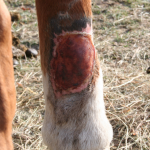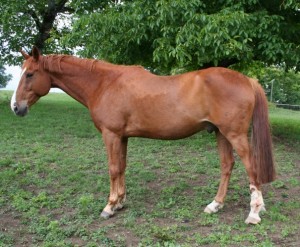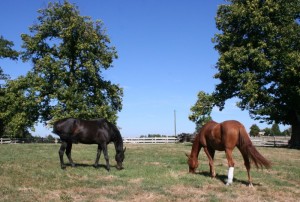Leo was bred to be an eventer, with a lovely pedigree. He was bought as a youngster from the breeder by an English lady for her daughter to event, but when that didn’t come to pass, he was such a sweet boy that she couldn’t bear to part with him, and rode and schooled him herself, planning to keep him forever. He was safe, gentle and brave, just the perfect horse and had a wonderful time together until Leonide suffered a dreadful wire injury in an field accident in late 2008.
In early 2009, we were contacted by her as she was having to quickly relocate back to the UK. Her circumstances dictated that she needed to rehome him and asked could ERF help. She had almost decided to have him put to sleep as she felt it unfair for him to be in continual pain and on continual box rest with occasional limited turnout in a very small muddy walled area.
Because the injury occurred overnight in the field, he wasn’t found quickly enough for the stitches to hold the wound together.
In France injuries seem to be more prone to proud flesh, and this was causing Leo all his problems. She had spent a small fortune on vet fees and he twice had to have the excess flesh cut off under local anaesthetic, very distressing for both him and his owner. Understandably when it was happening again she did not want to put her beloved horse through yet more stress and pain. Unfortunately, the vet could not advise her on a course of treatment to prevent the re-occurrence of the granulation.
She sent us some photographs of the progress of the wound, and we went to see him in late February. At the time of injury, the vet had told Leo’s owner the tendons were severed and that he would never be sound, let alone rideable. After seeing him walked about he seemed stiff, but had good use of the limb.
(All thumbnails are clickable to see the healing process more clearly)
When we saw the wound as below, we thought with experience of successfully healing written off proud flesh wounds we could help, and said we would take him in the middle of April, before the owner had to return to the UK.
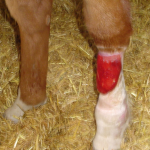
When Leo arrived, he had not travelled well and was extremely stressed so we let him settle and had a full assessment the next day.
He had lost weight, his feet had suffered from being continually stabled and Leo was clearly very unhappy at the (up to that point neccessary) ongoing box rest. Although we were aware of a very slight lameness, he clearly wasn’t in much pain, but we were horrified at the escalation of the proud flesh.
We took veterinary advice and all that could be offered was to continue cutting the proud flesh off. Because that had already failed twice as a solution, we took the decision to try and heal the leg in such a manner that allowed him to be outside and at least working the leg (swollen to twice the width of the other hind not withstanding the proud flesh) and being a horse. We turned him out, and he was so happy!!
So the process of trying to heal the wound began. At that point we had no idea how difficult it would be or how long it would take, but as Leo was quite happy, and not in pain, we decided to persevere.
Two weeks after arrival, the leg had changed to this, with the proud flesh starting to break up. We were using a well padded pressure bandage which was helping the whole leg, and Leo seemed comfortable.
By the end of May we were delighted with the progress,and feeling very positive. We used a multitude of products at various times, as each time the wound changed we had to alter what was required for that particular few days.
Then disaster struck. Leo’s skin was like paper, and very sensitive, and the skin below the hock at the back of the leg became sore over a matter of 24 hours as a result of the bandaging. We had to stop pressure bandaging, and as a result the limb began to swell again, changing the border of the wound. So various methods of using tubigrip to keep the dressings in place ensued, and once again the proud flesh disappeared. By October the wound had reduced to the size below.
Keeping on top of it over the winter was difficult, what with the wet weather making it difficult to keep the wound dry given the complications of bandaging, so progress was limited in the reduction of the proud flesh. Leo still looked happy, although he had developed a strange walk. He was sound in trot and canter, but looked as if he had stringhalt in walk.
By March of 2010, the wound had reduced, and more importantly, the thickening of the lower limb was disappearing, and the delineation of the fetlock and hock were more apparent.
The spring and summer made keeping the wound drier easier, and by July we could treat the wound without always covering it, and he was such a happy boy!
By September 2010, we had healed the wound to the extent it was only slightly raised, and needed no more bandaging, just topical applications.
At this point, some prospective guardians came to look at another horse we had for rehoming and fell for Leo.
We were reluctant to let him go because of the ongoing wound, but as Leo would be kept nearby, and we would be on hand for any problems, we decided to let him go as a companion.
Here he is in his glorious retirement in the lap of luxury.



